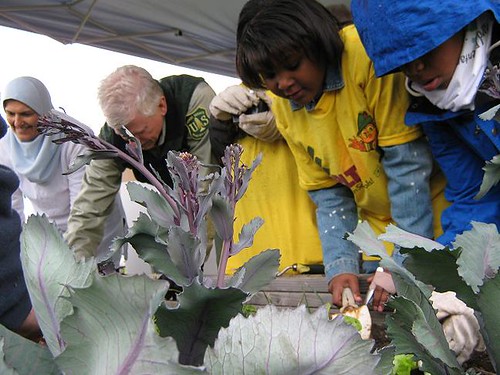
Mark Haskell has perfected the school garden recipe: a green thumb, a passion for home-grown food, culinary expertise and partnerships with GreenSchools! and the U.S. Forest Service to whip up the excitement of urban school children connecting their garden to the food they eat.
“You can use a garden to teach all sorts of things,” said Haskell, a certified master gardener and CEO and chef of Friends and Food Inc. in Washington, D.C. “Before we started these projects, a lot of these kids didn’t know where the food that they see on their plates came from.”
GreenSchools! is a partnership between the American Forest Foundation’s Project Learning Tree program and the Forest Service. The school gardens and other activities developed through GreenSchools! are a complement to USDA’s People’s Gardens and First Lady Michelle Obama’s Let’s Move! Initiative.
The key to the GreenSchools! program is that it provides leadership opportunities for students to investigate their school’s environmental footprint and then take action to reduce it. They help create a more green and healthy living environment by engaging their family, community members and the school’s administrators, teachers and support staff.
One of the more powerful learning tools used by GreenSchools! is having students establish school gardens, which sometimes includes building raised beds, tilling the soil, planting the seeds and harvesting the crops. Some of the harvest is used by the schools while other schools donate to local food banks.
The benefit of the gardens is that they serve multiple learning uses. Teachers can turn the garden into real-life lesson plans for math, science, history, art, social studies and literature. That’s where Haskell comes in, helping DC schools connect gardening to the work they’re doing in the classroom.
“The key is to sit down with teachers and find out what they need to accomplish and show how we can do it in the garden,” Haskell said.When students are outside learning in the garden, their imaginations are released and their bodies are moving.
In Washington, D.C., Barnard Elementary School students grow vegetables and donate them to Martha’s Table, a local community organization that provides needy children and families with nutritious meals. “We are in the gardens all year round, not just in nice weather,” said teacher Geraldine Meredith. ““We have a life-science standard about the cycle of life. What better way to learn than to see the garden grow in one season, die in winter then grow again.”
Editor’s note: This blog contains information provided by Project Learning Tree GreenSchools!
